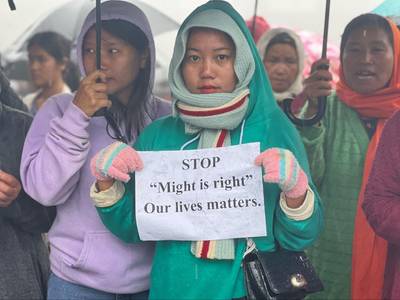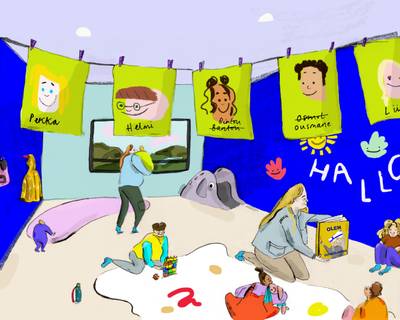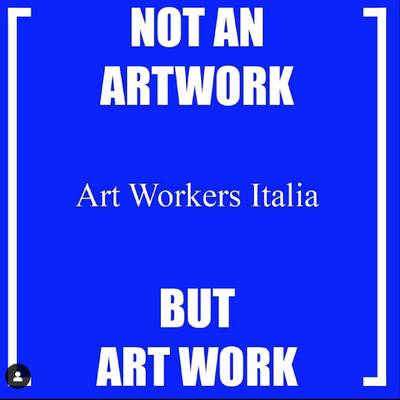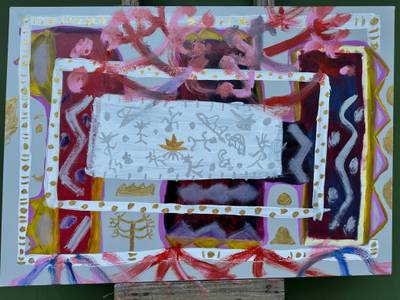

Illustration: Elina Johanna Ahonen
Vera Kavaleuskaya is a curator and editor born in Minsk and based in Helsinki. She is the co-founder and commissioning editor of the platform statusproject.net, launched in the frame of the collective research project STATUS: The Role of the Artist in the Changing of Society. The project brings together artists and cultural workers with a common goal to analyze the conditions of artistic practice and give visibility to the people who conduct it in today’s world.
Lately, I have established a special bond with some of my friends – surprisingly, over the specific use of a certain emoji. Independently from one another, we began reclaiming a loudly crying face to denote the feeling of being overwhelmingly pained by beauty and our inability to grasp it fully, be it the splendor of nature or a compassionate human connection. Not that this use itself was too uncommon, but rather the permanence and frequency of it, and the tendency to misread this symbol from the others’ side. And although a smiling face with tear emoji does exist, allowing some institutionalized validation of sorts, we do not find it applicable since it is too predetermined and does not express the cathartic depth of the joy felt.
Although we all have been impacted by the latest months on a different scale, it would be safe to assume that considerably many of us are, more than ever, longing for the same things: presence, company, collectivity, touch, affection, intimacy.
I sit on my balcony, drowning in the sunlight and surrounded by peas I grow that have firmly locked their tendrils. Living here, in Finland, sometimes feels like daydreaming. Although the effects of the pandemic are far from being unnoticeable, it is still one of the places which were the least touched by it. By contrast with Finland, the criminal government of my home country has brought a lot of pain in the last months besides mishandling the pandemic: by torturing political prisoners, killing protesters, jailing my friends and colleagues, expelling its citizens from their homes, and much more. It feels as if in my body this pain has dug a grave, which is now, even if overflowed with happiness, always touching upon something excessively sensitive residing in much deeper. Nevertheless, it is this cavity that allows me to experience what stands behind “loudly crying” without consciously assigning it with a more precise name: an overpowering affect enabling me to feel the sublimity of hope. Even if this hope is a mirage, I am, for now, readily accepting this atonement.
Although we all have been impacted by the latest months on a different scale, it would be safe to assume that considerably many of us are, more than ever, longing for the same things: presence, company, collectivity, touch, affection, intimacy. Probably, also for predictability, control, and ability to exercise one’s own agency. It is complicated to avoid generalization when measuring the lack of something this abstract (or even classifying these concepts) within a massive heterogeneous group of peoples: we grasp the world through our senses, and the way we interpret that sensual data is mediated by many factors, such as our cultures or class, and hence is not objective. Nevertheless, our everyday environment has recently transformed in such a drastic way that it allows us to make a broad judgment about the change in our emotional states that has followed, and to recognize the existence of this change as being shared. And once again, I want to address exhaustion as a part of this complex state.
Writing about exhaustion exhausts me even more. But it also allows me to notice that the intensity of exhaustion is not stable: it peaks when I have to continue to be subject to something that has made me exhausted in the first place. When the unwelcome stimulus goes away, exhaustion steps to the background, making room for something else. Therefore, I can deduce that exhaustion is not an isolated phenomenon that exists only in my body. And for it to come into sight, it needs to be activated and recognized. Recognition occurs when the exhaustive action wants to repeat itself, but the object of its exertion cannot provide the desired outcome anymore, and consequently, it is exposed as depleted. It means that, rather than seeing an exhausted human body as a psychiatric object that disproportionately responds to a particular normalized force or abstract stress, we should look at exhaustion as a regime. This regime includes both an exhausted object and a structure that continues to exploit the object while claiming ownership over it.
Rather than seeing an exhausted human body as a psychiatric object that disproportionately responds to a particular normalized force or abstract stress, we should look at exhaustion as a regime.
Art workers are often pushed to take on a role of a “strong” practitioner: assertively knowledgeable, efficient, productive, and smoothly functioning within the post-Fordist economy – and it is not even a deliberate position but a matter of survival. Whether working on a permanent contract or as freelancers, as cognitive workers we perform in the environment where, as Antonio Negri argues, our boss is “financial capital which extracts social value” (Negri, 2015). Alongside that, we are constantly facing endless institutionalized mining of affect, since affective labor is what an art worker – especially a female – is expected to master. Saskia Sassen refers to this form of capitalism as extractive: it is excavating resources, profit, and value both from the Earth and from the bodies, using the same core principle to exhaust them in all possible ways (Sassen, 2014). Moreover, the time of a worker is also seized in its totality. We do not belong to ourselves when we rest after work: we need this time to recuperate for upcoming tasks, and it is pragmatically included in the production cycle. I presume that many of us have always been exhausted, not least because our invisible boss has claimed the rights to the social value and the affects we produce, and the time we own. The global pitilessness of the novel pandemic has magnified the fundamental problems of our everydayness and proceeded with attaching personal tragedies to it. But then, how can we oppose something while being stripped of the desire to act? How can we figure out the ways to confront exhaustion, but in a non-framed and non-predetermined way?
There is a hint that the time taken from us by the financial capital may in some sense be retaliated by the excess of time we produce collectively. Philosopher Oleg Aronson suggests that we can find truly liberated time in two situations: when retired or subjected to affect. And while being retired intrigues me personally, I shall concentrate on his reflection upon the latter. By affect, Aronson means neither an individual experience nor emotional excitement. Affect is a moment when we do not belong to ourselves and are exposed to external forces. It gives an excess of time and sensation, which exceeds one’s possibilities of perception. It implies perceiving something that one is not ready to grasp, something redundant to individual capabilities. In this sense, affect never belongs to one person: it always belongs to this excess; it is arranged differently and according to other rules. This incomprehensible excess, in its turn, belongs to others, but at the same time, no one can pinpoint it. It evokes a sense of belonging, togetherness, inclusion into the world and unalienated existence with others. Affect relates to the economy of gift and generosity rather than the economy of exchange and accumulation. An artist, in her turn, is a participant in a collective production of affect, who finds it in unexpected places, opposing culturally pre-fixed and permitted affects, and eludes its authorship (Aronson, 2015). Furthermore, affects, encountered in a variety of situations ranging from a dancefloor to a protest, not only evoke the sense of belonging to something “more than us”, but are consequently involved in the production of common subjectivity and transformation of the social body.1
3.*
The whole idea of this text was to convince you (or to wink at each other, depending on your ideological position) to evade the rigid notion of professionalism, to not accept the invisible hand, and to kill the joy but to then revive it on your terms. And here I am, unable to do exactly this due to a suffocating internalization of a belief in an ideal way to deliver an argument.
I was fine until I discovered my inability to finish this text. I can hardly give up the idea of shaping it the way I think I want it to be. I can hardly give up the desire to make it professional because I am “a professional”: I know how to write, and I also know how to assist others with writing their texts.
It is striking to notice how different people whom I work with cope with stress and trauma while composing a text about it. Some are producing one essay after another to mute their anxiety ignited by the dangers of state terror. Some, on the other hand, are going through psychotherapy to be able to complete the essay that addresses their imprisonment. In the face of death, injury, and injustice, speculating about the position of an art worker within the neoliberal society seems especially absurd – but probably not more absurd than the professionalized field itself.
Why will I continue with the same actions that lead to my exhaustion in the first place? Out of the belief that the human body can heal itself and carry on? Mine is stubborn, and all it wants is to sleep and stare at how seasons are turning. The whole idea of this text was to convince you (or to wink at each other, depending on your ideological position) to evade the rigid notion of professionalism, to not accept the invisible hand, and to kill the joy but to then revive it on your terms. And here I am, unable to do exactly this due to a suffocating internalization of a belief in an ideal way to deliver an argument: a straight A student is fighting with a bent slacker. But I will attempt to proceed with writing in the way I have planned – at least out of curiosity.
So here we are: fatigued but still needing to pay the bills. We may appreciate our work or occupation, sometimes using it as an opportunity to wrap our minds around “something else” as a coping mechanism. We also willingly participate in the restarted cycle of events (at least for now), which may give us the long-awaited sense of involvement. But even then, something is still off.
In contemporary Western societies, being happy is treated as a commodity and is almost compulsory (as opposed to thinking of it as of the commons and a political project). The idea of happiness interconnects with individual well-being, which includes having good physical and mental health, prosperity, and work-life satisfaction. As Sara Ahmed argues, under the conditions of compulsory happiness, being unhappy becomes a right to demand. Unhappiness should be radicalized and seen as a political freedom: the freedom to express unhappiness, to live with it, and to affect others with it. Therefore, recognizing what induces unhappiness is a part of our shared political cause, and effectively challenging the idea of happiness should become a shared project (Ahmed, 2010). I suggest looking at exhaustion from the same angle: as a part of our shared political cause and a freedom to demand.
With the circulating imperative that urges to use contemporary art as a tool for “supporting the community” (with the community quite often being an abstract one), it is easy to expect that we will be faced with the influx of events and exhibitions that claim to do exactly that – this time, by addressing the pandemic, its consequences, and influence on “us”. Self-organized, artist-run structures, and some of those operating with the public money, would, in most cases, be well-intentioned and sincere in such claims, especially if nurturing their publics has always been their priority. The candidness of other art institutions – especially the private ones, although this division is not a certain rule – could be questionable or even hard to believe. It can be easily imagined that this support will include healing as a follow-up on hospitality, care, diversity, and other healthsome concepts. But can we, as heterogeneous groups of peoples, accept this institutionalized “healing”, either as subjects or objects, invited to contribute or participate? Healing for what and for whom would it be? And what kind of healing should we really strive for?
If we consider art institutions as sites for the transmission of affects, then it is in our power to initiate the movement (crawling, creeping along, galloping) towards the acknowledgement that our exhaustion is shared, and from that – to forming the community of convalescents. The excess of time that experiencing affect collectively grants us, may offer a temporal yet temporary cure.
I argue that “healing” coming from the top-down position of power may only reinforce the pathologization of a presumably sick body – in this case, atomized bodies, whose alienation is the byproduct of neoliberal ideology. If we understand exhaustion as a regime caused by different types of structural violence – extractive capitalism in particular, which I am looking at for this text – it would be possible to notice that institutions, which may offer the so-called cure, would simultaneously be part of the problem. The obligation to perform, produce, and participate, all on particular terms dictated by art institutions functioning within capitalist logic, perpetuates the same narratives of extraction. It is impossible to heal exhaustion by inflicting it, and it is difficult to ignore the necessity of structural changes in these institutions as well as in their immediate networks. Although such institutions may potentially offer temporary aid by providing familiar experiences to both public and art workers, this aid also has the power to worsen the struggle by proclaiming quasi-collectivity and offering future scenarios saturated with what Lauren Berlant would call “cruel optimism”.
It could be more constructive to see the state of exhaustion as a horizon of the collective experience and to use it as a common denominator when building a particular form of solidarity, as Jan Verwoert suggests. Verwoert formulates it so aptly that it is best to quote all of the following: “A solidarity that would not lay the foundations for the assertion of a potent operative community, but which would, on the contrary, lead us to acknowledge that the one thing we share – exhaustion – makes us an inoperative community, an exhausted community, or a community of the exhausted. A community, however, that can still act, not because it is entitled to do so by the institutions of power, but by virtue of an unconditional, exuberant politics of dedication. In short, because, as a community of convalescents, we realise in an empty moment of full awareness, that we care” (Verwoert, 2008).
If we consider art institutions as sites for the transmission of affects, then it is in our power to initiate the movement (crawling, creeping along, galloping) towards the acknowledgement that our exhaustion is shared, and from that – to forming the community of convalescents. The excess of time that experiencing affect collectively grants us, may offer a temporal yet temporary cure. But the excess of sensation provides our numb limbs with an impulse to move again, without the piercing pain. If we, art workers, are repeatedly required to produce affect on demand, let it be – especially now – the non-co-opted affect of collective idleness. Let it be the affect that, through joy2, gives impetus for political transformations and helps to imagine a new project of a just future without exhaustion.
All I want to do is to hold your hand and cry tears of joy. But when it offers me the hand, it is the hand that takes. It captures and expropriates our affects, leaving us with the unfulfilled promises of collectivity. In return, it offers prefabricated forms of tenderness and streams of commodities and careers. If we cannot retire yet, we can still seek to slip away.
We aim for the hand of solidarity, for standing shoulder-to-shoulder, for sharing a karaoke mic together. We are looking for ruins and gaps, for defiant affects, for ways of resisting the totality of the institutionalized art field, for strategies to evade the enslaving labor, for a new social body. We do not want to participate, and we side with those who refuse too.
And in the struggles against capitalist exploitation, the rule of property, and the destroyers of the common through public and private control, we will suffer terribly, but still we laugh with joy. They will be buried by laughter.
— Michael Hardt, Antonio Negri, Commonwealth







